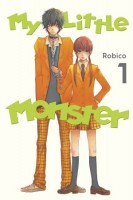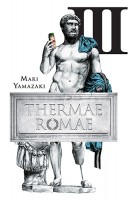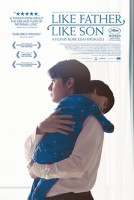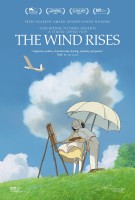My News and Reviews
Last week the Smuggler Giveaway Winner was announced. As usual, I took the opportunity to compile a list. In this case, I pulled together some of the manga licensed in English that feature assassins. And speaking of assassins, last week I reviewed Hiroaki Samura’s Blade of the Immortal, Volume 28: Raining Chaos which focuses on the confrontation between the remnants of the Ittō-ryū and the Rokki-dan warriors and the Mugai-ryū assassins. There isn’t much plot development in the volume, but there are some great battle sequences. I also reviewed Real, Volume 2 by Takehiko Inoue, which features battles of an entirely different sort. Real is a mix of human drama, tragedy, and hope as its characters deal with events in their lives beyond their control. It’s a truly fantastic series.
There was quite a bit of manga industry news and analysis last week. I’m particularly excited that Moyoco Anno will be a featured guest at TCAF! ICv2 interviewed Dark Horse’s manga editor Carl Horn (Part 1, Part 2). Deb Aoki took a look at the state of digital manga for Publishers Weekly. Vertical’s licensing survey is currently underway. Vertical also posted a little more information about past surveys and how they’ve been used. Sean Gaffney rounds up some of the recent licensing announcements at A Case Suitable for Treatment. Not directly related to the current state of the manga industry but still worth a read is Dan Mazur’s post about early shōjo manga.
Quick Takes
 My Little Monster, Volume 1 by Robico. On the first day of school, Haru was suspended and he hasn’t been back since. As a favor to a teacher, Shizuku agrees to bring him his homework which Haru interprets as a sign of friendship. Now, much to Shizuku’s dismay, the two of them have become nearly inseparable. Because of Haru’s propensity towards violence and his almost complete lack of understanding as to what is socially appropriate behavior, some of the situations in My Little Monster can be extremely uncomfortable and worrisome. However, although they are often used as a source of humor, I was very happy to see that Haru’s actions were not romanticized. His tendency to lash out and physically intimidate others, whether out of fear or for some other reason, was not generally portrayed as a desirable characteristic. It’s completely understandable that some people are afraid of him. However, Haru’s naivety and earnestness can be very endearing. Shizuku, one of the few people who can seem to handle the volatile Haru, is an interesting character in her own right with both flaws and strengths. They are both social misfits in their own ways; I’m very curious to see how their relationship continues to develop.
My Little Monster, Volume 1 by Robico. On the first day of school, Haru was suspended and he hasn’t been back since. As a favor to a teacher, Shizuku agrees to bring him his homework which Haru interprets as a sign of friendship. Now, much to Shizuku’s dismay, the two of them have become nearly inseparable. Because of Haru’s propensity towards violence and his almost complete lack of understanding as to what is socially appropriate behavior, some of the situations in My Little Monster can be extremely uncomfortable and worrisome. However, although they are often used as a source of humor, I was very happy to see that Haru’s actions were not romanticized. His tendency to lash out and physically intimidate others, whether out of fear or for some other reason, was not generally portrayed as a desirable characteristic. It’s completely understandable that some people are afraid of him. However, Haru’s naivety and earnestness can be very endearing. Shizuku, one of the few people who can seem to handle the volatile Haru, is an interesting character in her own right with both flaws and strengths. They are both social misfits in their own ways; I’m very curious to see how their relationship continues to develop.
 Thermae Romae, Omnibus 3 by Mari Yamazaki. If it seems like it’s been a long time since the last Thermae Romae omnibus was released, that’s because it’s been almost a year. Thermae Romae is a series that started out more like a gag manga, following the exploits of the Roman bath engineer Lucius as he somehow time travels to modern-day Japan and back after repeated near-drownings. With the second omnibus, the series shifts into a romantic comedy when Lucius meets Satsuki after becoming stuck in Japan. That ongoing plot continues through the rest of the series. Although there is still plenty of humor in the third omnibus, Thermae Romae takes a decidedly more serious turn when it looks like Satsuki and Lucius will be torn apart. Satsuki’s grandfather, an incredibly skilled massage artist (as well as a man who should definitely not be trifled with), plays an increasingly important role in the story. Thermae Romae is a great deal of fun. It has drama and romance and comedy, not to mention great art. The ending does feel a little abrupt, but Yamazaki notes that she hopes to write additional Thermae Romae stories that address some of the lingering questions that readers may have about the series and its characters.
Thermae Romae, Omnibus 3 by Mari Yamazaki. If it seems like it’s been a long time since the last Thermae Romae omnibus was released, that’s because it’s been almost a year. Thermae Romae is a series that started out more like a gag manga, following the exploits of the Roman bath engineer Lucius as he somehow time travels to modern-day Japan and back after repeated near-drownings. With the second omnibus, the series shifts into a romantic comedy when Lucius meets Satsuki after becoming stuck in Japan. That ongoing plot continues through the rest of the series. Although there is still plenty of humor in the third omnibus, Thermae Romae takes a decidedly more serious turn when it looks like Satsuki and Lucius will be torn apart. Satsuki’s grandfather, an incredibly skilled massage artist (as well as a man who should definitely not be trifled with), plays an increasingly important role in the story. Thermae Romae is a great deal of fun. It has drama and romance and comedy, not to mention great art. The ending does feel a little abrupt, but Yamazaki notes that she hopes to write additional Thermae Romae stories that address some of the lingering questions that readers may have about the series and its characters.
 Arakawa Under the Bridge, Season 1 directed by Akiyuki Shinbo. The Arakawa Under the Bridge anime series is based on an ongoing manga by Hikaru Nakamura. Kou Ichinomiya lives his life following one very simple rule that has been instilled in him by his father: never be indebted to another person. So when Nino, a rather strange young woman living on the banks of the Arakawa River, saves him from drowning, Kou wants to repay the favor and move on as quickly as possible. Except, the only thing that she wants is for him to stay with her and so Kou finds himself obligated to move in under the bridge. There he meets the other residents of the Arakawa River, all of whom are not just a bit peculiar and strange. Though Kou is supposedly the “normal” one, it quickly becomes obvious that he fits right in and is just weird as the rest of them. I found Arakawa Under the Bridge to be highly entertaining and enjoyable in all of its absurdity. The series doesn’t have much of an ending, which makes some amount of sense seeing as there is a second season (which I’ll definitely be watching), but the anime tends to be fairly episodic so I wouldn’t necessarily expect it to have a definitive conclusion, either.
Arakawa Under the Bridge, Season 1 directed by Akiyuki Shinbo. The Arakawa Under the Bridge anime series is based on an ongoing manga by Hikaru Nakamura. Kou Ichinomiya lives his life following one very simple rule that has been instilled in him by his father: never be indebted to another person. So when Nino, a rather strange young woman living on the banks of the Arakawa River, saves him from drowning, Kou wants to repay the favor and move on as quickly as possible. Except, the only thing that she wants is for him to stay with her and so Kou finds himself obligated to move in under the bridge. There he meets the other residents of the Arakawa River, all of whom are not just a bit peculiar and strange. Though Kou is supposedly the “normal” one, it quickly becomes obvious that he fits right in and is just weird as the rest of them. I found Arakawa Under the Bridge to be highly entertaining and enjoyable in all of its absurdity. The series doesn’t have much of an ending, which makes some amount of sense seeing as there is a second season (which I’ll definitely be watching), but the anime tends to be fairly episodic so I wouldn’t necessarily expect it to have a definitive conclusion, either.
 Like Father, Like Son directed by Hirokazu Kore-eda. Ryota and Midori Nonomiya are stunned when they discover that their son Keita isn’t related to them biologically. Six years ago at the hospital where he was born, Keita was somehow switched with Ryusei, the son of Yudai and Yukari Saiki. Now the two families must decide how to handle the situation and whether blood ties are stronger than those of time. Ryota, who has his own father issues to work out and whose relationship with Keita wasn’t especially strong to being with, is having a particularly difficult time, but his wife is struggling tremendously as well. The members of the Saiki family tend to be a little more easy-going in comparison, but the situation is a challenge for them as well. And caught up in the whole mess are Keita and Ryusei, who have very little say in the matter. The revelation of the two boys being switched at birth disrupts both families, resulting in both joy and heartbreak as they grow to know each other better. Like Father, Like Son is a beautiful film about parental and familial love as Ryota learns what is important in life and what it really means to be a father.
Like Father, Like Son directed by Hirokazu Kore-eda. Ryota and Midori Nonomiya are stunned when they discover that their son Keita isn’t related to them biologically. Six years ago at the hospital where he was born, Keita was somehow switched with Ryusei, the son of Yudai and Yukari Saiki. Now the two families must decide how to handle the situation and whether blood ties are stronger than those of time. Ryota, who has his own father issues to work out and whose relationship with Keita wasn’t especially strong to being with, is having a particularly difficult time, but his wife is struggling tremendously as well. The members of the Saiki family tend to be a little more easy-going in comparison, but the situation is a challenge for them as well. And caught up in the whole mess are Keita and Ryusei, who have very little say in the matter. The revelation of the two boys being switched at birth disrupts both families, resulting in both joy and heartbreak as they grow to know each other better. Like Father, Like Son is a beautiful film about parental and familial love as Ryota learns what is important in life and what it really means to be a father.
 The Wind Rises by Hayao Miyazaki. The anime film The Wind Rises is historical, biographical fiction, following the life of Jiro Horikoshi, an aeronautic engineer who designed fighter planes for Japan during World War II. Almost as much of the film takes place in Jiro’s dreams as it does in his waking life. At first, the designs of the planes in The Wind Rises are very fantastical but as the film progresses they become more and more realistic as Jiro makes his dreams a reality. There is an emphasis placed on the beauty of design and creativity, but this is contrasted with the ugly, destructive forces of war and the terrible applications of those innovations. His planes may have been beautiful, but their purposes were not, which begs the question–how much responsibility do artists hold over their creations and their use? The Wind Rises‘ answer to that question is left ambiguous. As with many of Miyazaki’s other films, The Wind Rises has gorgeous flight sequences and an anti-war sentiment. Some of the time skips were a little difficult to follow at first, and I think the film was a little longer than it really needed to be, but overall The Wind Rises was well done. It’s far from my favorite Miyazaki film, though.
The Wind Rises by Hayao Miyazaki. The anime film The Wind Rises is historical, biographical fiction, following the life of Jiro Horikoshi, an aeronautic engineer who designed fighter planes for Japan during World War II. Almost as much of the film takes place in Jiro’s dreams as it does in his waking life. At first, the designs of the planes in The Wind Rises are very fantastical but as the film progresses they become more and more realistic as Jiro makes his dreams a reality. There is an emphasis placed on the beauty of design and creativity, but this is contrasted with the ugly, destructive forces of war and the terrible applications of those innovations. His planes may have been beautiful, but their purposes were not, which begs the question–how much responsibility do artists hold over their creations and their use? The Wind Rises‘ answer to that question is left ambiguous. As with many of Miyazaki’s other films, The Wind Rises has gorgeous flight sequences and an anti-war sentiment. Some of the time skips were a little difficult to follow at first, and I think the film was a little longer than it really needed to be, but overall The Wind Rises was well done. It’s far from my favorite Miyazaki film, though.